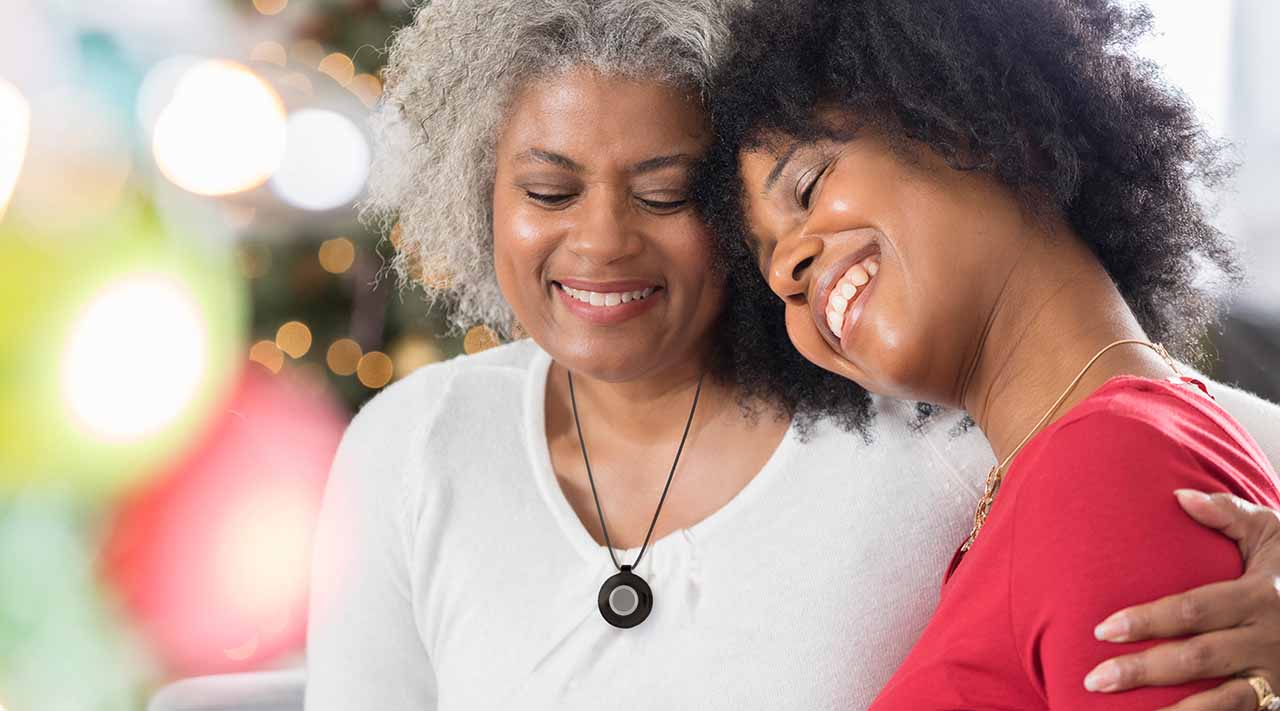The most important thing about a Medical Alert system is that it stays on your body, where it belongs, to do its job. Apart from that, you need to decide which system is right for you and your lifestyle. Here are the top five considerations when choosing a medical alert system:
Is it waterproof?
Yes, the buttons on Medical Alert’s pendants and bracelets are waterproof—a crucial feature since 80% of at-home falls occur in the bathroom, according to the National Institute on Aging. Even if the button gets wet, the wireless signal works just as well and calls in instantly to the emergency operator through the base unit. This feature gives folks the freedom to wear the pendant or bracelet in the shower or the bath. For added protection, our Automatic Fall Detection button is also waterproof.
One caveat: Waterproof protection in these systems lasts for roughly 30 minutes while submerged in water up to three feet deep—but there are no assurances, necessarily, beyond that time limit. So, it’s best to keep a leisurely bath to half an hour.
In addition, the On the Go GPS hand-held device is only splash-proof, not officially water-proof. So, swimming is not advised if you were thinking of tucking that phone-like device into the pocket of your swim trunks.
Do you need an in-home or mobile system?
Should you choose a GPS outdoor device, an at-home device tied to your landline, or an at-home device tied to your cell phone? Following are details on each option to help make an informed decision:
Mobile System
You probably think the GPS outdoor device sounds pretty great in its lifestyle reach—it has tracking capabilities that can alert the emergency operator no matter where you are outdoors. Errands and gym and volunteer work suddenly feel more comforting with a portable guardian angel. If you trip on the curb and fall; if you’re mugged; if you’re driving into a flash flood—whatever your emergency, our dedicated operator knows whom to call to help you immediately. All of this is possible with the press of a button.
The On the Go GPS version is a hand-held device resembling a phone, so you can tuck the pendant into your blouse but then carry around the hand-held device to stay under the radar if you’re self-conscious about wanting or needing protection. Adding fall detection technology to your GPS device helps identify the fall scenario when you can’t push the button.
Home System – Landline
You might think this system is just right for your desired level of protection. Most falls at home do occur in the bathroom, and you’re worried about this. Or, maybe you have the beginnings of osteoporosis and are vulnerable to broken bones from falls. Or your osteoarthritis interferes with healthy movement, increasing your susceptibility to mishaps like bumping into furniture.
Folks also worry about fires, which can occur with the forgetfulness tied to aging. Or they’re worried about break-ins and feel vulnerable in their frailty.
All of these factors add up to creeping insecurity and can disrupt the safe-haven setting your home has always provided. In addition, loved ones want to know you’re both independent and safe.
The at-home landline system offers the simplicity of one base unit with a two-way speakerphone tied to your landline. For those who are on a fixed income, this is a good option thanks to the no-contract, inexpensive monthly rate of $22.95 per month. ($10 more, and you’ve got the fall detection button, too.)
Home System – Cellular
You might think this system is spot-on for you. You hardly use your landline or outright drop it for budget reasons. You use your cell phone to stay connected with your loved ones and to stay looped into activities. The ease of the system, for you, compares to the ease of the landline system: One base unit; and one (or two) buttons to offer ultimate fall protection. Your safety concerns are limited to your home, and this is one neat system that optimizes your home and your ever-versatile cell phone with around-the-clock protection.
Is the Emergency Services Call Center rated properly?
Medical Alert has multiple, fully redundant, 5-diamond, UL-certified, interlinked monitoring centers located in the U.S.A. there to help 24 hours a day, seven days a week. All emergency centers are staffed by SIA-certified multilingual operators.
Once you push the button on your device, dedicated supportive operators are trained to determine the exact help you need and they do the calling for you. Whether you need a relative or an emergency response team, the operator is trained to make that decision instantly and to stay on the line until help arrives. Depending on the situation, the operator will dispatch an ambulance or contact a firefighter or a police officer.
What are the cost considerations?
Whether you’re on a fixed income or have room in your budget for a Medical Alert system, know this: Medical Alert is one of the most reasonably priced systems among the top 10 rated systems in the country, according to a 2018 Consumer Reports review. You can opt to go month by month, with no contract, especially if you just want to try out a system. Or, you can opt for a semi-annual discount plan. Here are the costs of Medical Alert’s various systems:
- Home Systems: Starting at $19.95/mo.
- Mobile Systems: Starting at $39.95/mo.
*The Fall Detection feature, which includes an additional button on the bracelet or pendant, adds only $10 monthly to any of the systems.
What are the options for wearables?
You can choose to wear either an attractive pendant or a bracelet resembling a watch or a wearable fitness tracker.
The white pendant with a black strap is one-size-fits-all; you can swap in your own necklace chain if you prefer. Remember: it’s the button that operates as the device, but if you’re going to choose your own lanyard, be sure to select one with a break-away feature for safety’s sake.
Wear our alert pendant or bracelet at all times. Whether close to your heart or close to your hand, the device offers concentrated protection—in the modern simplicity of a button.




